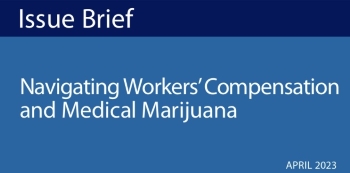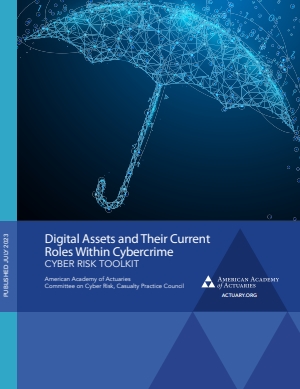Casualty Quarterly, Summer 2023
Vol. 7 | No. 2
Date:06/03/2023
Q&A-Medical Marijuana Issue Brief
Ross
The Workers’ Compensation Committee released an issue brief, Navigating Workers’ Compensation and Medical Marijuana, providing an overview of medical marijuana laws and court cases-and the impact they have on the workers’ compensation system-to help actuaries navigate the complicated legal landscape.
Key points in the issue brief include:
Medical marijuana can impact workers’ compensation before, during, and after a workplace injury.
Workers’ compensation actuaries should work closely with claims professionals to understand the potential implications of medical marijuana laws on their projections.
There is significant complexity involved with the interpretation of workers’ compensation law when medical marijuana use intersects with workers’ compensation claims; and research on medical marijuana use, reimbursement of claims, and treatment options is needed.
Casualty Quarterly did a Q&A with committee Vice Chairperson Krystal Ross on the issue, which members will present on at the Casualty Loss Reserve Seminar in Orlando in September, sponsored jointly by the Academy and the Casualty Actuarial Society. A P/C breakout session on the topic is also scheduled for the Academy’s Envision Tomorrow: 2023 Annual Meeting in November.
Marijuana laws seem to be some of the most fast-changing in the country, with even more states moving toward legalization in the few months since the issue brief was published-Maryland legalizing small amounts as of July 1 being among the most recent. Have any states, since publication, taken any action on marijuana in the workers’ compensation space?
As we drafted the issue brief, the map that we referenced kept changing. So, it shouldn’t be to anyone’s surprise that it looks different now than it did at publication. There are three changes that have occurred since, with Maryland being one of those. Delaware actually changed after the brief completed its final review, but before it was officially published, legalizing recreational marijuana usage as of April 22. The third state is Louisiana, which decriminalized possession of marijuana, effective Aug. 1.
Court cases also continue to impact the reimbursement of marijuana for workers’ compensation claims. As an example, Pennsylvania was identified in the issue brief as a state that could not require insurance carriers to reimburse for medical marijuana through a court decision. A subsequent court case earlier this year overturned that decision, stating that insurers are now required to reimburse when the treatment is deemed “reasonable and necessary.”
Given the rapid changes in the legal landscape of the states, what are some of the biggest issues around these changes-requirements for workers’ compensation carriers to reimburse for medical marijuana use?  The biggest issue is, “What is the situation today?” Any carrier, claims adjuster, or actuary needs to be on top of the latest changes in order to avoid any missteps. Specifically on the topic of reimbursement, I think the most significant impact is ensuring that you know whether the state you are conducting business in has mandated reimbursement. In most states, these concepts haven’t made their way into law yet and remain in the hands of the courts. There are laws pending-such as HB 1949 in Massachusetts-that should be monitored.
The biggest issue is, “What is the situation today?” Any carrier, claims adjuster, or actuary needs to be on top of the latest changes in order to avoid any missteps. Specifically on the topic of reimbursement, I think the most significant impact is ensuring that you know whether the state you are conducting business in has mandated reimbursement. In most states, these concepts haven’t made their way into law yet and remain in the hands of the courts. There are laws pending-such as HB 1949 in Massachusetts-that should be monitored.
The issue brief makes mention of a recent federal law that was passed in 2022 (H.R. 8454). How beneficial to the workers’ compensation space would federal legalization be, and how useful would the research provided by the 2022 law be to insurers?
The easiest answer is that federal legalization would help avoid state-by-state interpretation of whether or not the federal law trumps state law. Courts across the country have spent numerous hours debating this topic and have come out with different perspectives.
Regarding the latest federal law and marijuana research, the new law will aid in understanding the true impacts marijuana has on an individual. A significant portion of medical usage is based on anecdotal information, especially in the U.S. I also expect that the ability to conduct research will eventually lead to the ability to identify proper dosaging. Unlike other medications, there are no standards for the concentration of the chemical compounds found in medicinal marijuana products.
Opioids are obviously a big issue-perhaps bigger than marijuana nationwide, as the issue brief suggests. What are some of the key takeaways in comparing the two?
One of the things we all need to keep in mind is that opioids have been studied for many years. As mentioned earlier, marijuana can now be properly researched in the U.S. and therefore will likely be able to provide us with greater understanding of how opioids and marijuana inter-relate.
Another key takeaway is related to a comment I made earlier about dosaging. Doctors know based on a patient’s characteristics (age, weight, gender, pain level, etc.) what and how much to prescribe. The same information is not available for marijuana and therefore is only recommended to patients and injured workers as opposed to being prescribed.
What will you and committee members focus on during your presentations at CLRS and the Academy’s Annual Meeting?
Subcommittee members Anthony Bustillo and Kathy Thompson, who each played an important role in drafting the issue brief, will lead the CLRS presentation. They will be focusing on the impact of medical marijuana during different phases of a workplace injury. They will also be joined by a loss-control specialist providing a non-actuarial perspective. If you are attending CLRS, I encourage you to check out their session!
Kathy and I will also be presenting at the Academy’s Annual Meeting in November. We are still finalizing our panel, but I expect to have a workers’ comp claim specialist and someone in the regulatory or legal field join us. Stay tuned for more details and I look forward to seeing many of you there!
Register Now for December’s P/C Loss Opinions Seminar
Registration is open for the Academy’s 2023 Seminar on Effective P/C Loss Reserve Opinions, set for Dec. 4-5 in Charlotte, N.C. The annual seminar is designed for property/casualty actuaries who prepare or assist with preparing NAIC annual statements of actuarial opinion on P/C loss reserves.
One past attendee called the seminar a “great distillation of changing requirements and rules, as well as a good pooling of experience.”
The agenda includes sessions on actuarial standards of practice (ASOPs), range reserves, qualifications, and more. Register now for an early discount. Cyber Toolkit Adds Digital Assets Section
Cyber Toolkit Adds Digital Assets Section
The Committee on Cyber Risk released a new chapter in the Cyber Risk Toolkit. The new section, “Digital Assets and Their Current Roles Within Cybercrime,” aims to provide information for insurance industry practitioners whose lines of business may interact with digital assets and highlights recent trends surrounding their use within cybercrime.
Climate Risk Webinar Set for Aug. 9
Academy President-Elect and Climate Change Joint Committee Chairperson Lisa Slotznick will lead committee members in presenting the Aug. 9 webinar, “How Climate Risk Applies to All Actuaries.”
Discussion topics will include the recently released Climate Risks Pose Broad Impact on Financial Security Systems, which provides actuaries with a practical guide for considering a broad range of impacts that climate change may have on their work. Register today.
Recording Available for Latest Climate-Modeling Webinar
The Climate-Modeling Series held its third session on May 15 with “Connecting the Insurance Industry and Academia on Catastrophe and Climate Modeling: Webinar Series-Third Session,” part of the webinar series co-presented with the National Science Foundation and the National Oceanic and Atmospheric Administration.
The webinar focused on the state of the science, model inputs, resolution, variables of interest, and the expression of uncertainty from the perspectives of climate modelers and those using climate models. A recording of this webinar-and the previous ones in the series-are available to view on-demand.
CPC Webinar Examines Insurance Fraud
The Casualty Practice Council’s (CPC) June 28 webinar, “Insurance Fraud: Perspectives from the Market, Government, and Actuarial Profession,” featured three subject-matter-expert presenters who addressed the subject from various perspectives. Casualty Vice President Amy Angell moderated. Slides and a recording are available as a free member benefit.
ASB Actions on ASOP Nos. 20, 36 The Actuarial Standards Board (ASB) adopted a revision of Actuarial Standard of Practice (ASOP) No. 20, now titled Discounting of Property/Casualty Claim Estimates. The ASOP is effective for any actuarial work product covered by the standard’s scope issued on or after Dec. 1, 2023.
The Actuarial Standards Board (ASB) adopted a revision of Actuarial Standard of Practice (ASOP) No. 20, now titled Discounting of Property/Casualty Claim Estimates. The ASOP is effective for any actuarial work product covered by the standard’s scope issued on or after Dec. 1, 2023.
The ASB also approved a second exposure draft of a proposed revision of ASOP No. 36, now titled Statements of Actuarial Opinion Regarding Property/Casualty Loss, Loss Adjustment Expense, or Other Reserves. Information on how to submit comments can be found in the draft. The comment deadline is Nov. 1.
Early Discounts Available for CLRS Early-registration discounts are available through Aug. 18 for the 2023 Casualty Loss Reserve Seminar. Academy Senior Casualty Fellow Rich Gibson has been instrumental in gaining speakers for sessions at the annual CLRS.
Early-registration discounts are available through Aug. 18 for the 2023 Casualty Loss Reserve Seminar. Academy Senior Casualty Fellow Rich Gibson has been instrumental in gaining speakers for sessions at the annual CLRS.
Co-sponsored by the Academy and CAS, the annual CLRS will be held Sept. 11-13 in Orlando, Fla. For more information-including how to order discounted Walt Disney World theme park tickets-visit the CLRS webpage.
Academy Engages With Stakeholders at CAS Spring Meeting
Academy representatives attended the Casualty Actuarial Society (CAS) Spring Meeting in Boston, offering information on membership benefits, publications, and professionalism and public policy work. President-Elect Lisa Slotznick and Executive Director Bill Michalisin were recognized along with other actuarial organization leaders at the CAS Town Hall general session.
Membership Department staff provided information about joining the Academy, volunteer opportunities, and professionalism and public policy resources. For more information on the Academy’s casualty work products, visit the Casualty Public Policy webpage.
CPC, RMFRC Hold Hill Visits
The Casualty Practice Council (CPC) and the Risk Management and Financial Reporting Council (RMFRC) held their annual joint “Hill visits” with lawmakers, regulators, and policymakers from Capitol Hill offices and federal agencies in the nation’s capital.
As the public policy voice for the U.S. actuarial profession, the Academy undertakes “Hill visits” each spring with federal lawmakers and policymakers to develop relationships with and serve as a resource for public stakeholders.
Angell“Academy casualty volunteers enjoyed the opportunity to interact with federal officials and agencies on a variety of topics,” said Casualty Vice President Amy Angell. “Topics such as cyber risk, extreme events, affordability and unfair discrimination, and pandemic risk insurance are all vital to the public interest, and part of the Academy’s mission of serving the profession and the public.”
CPC and RMFRC volunteers met virtually with the White House Council of Economic Advisers and Council on Environmental Quality; Government Accountability Office; the Congressional Budget Office; the Congressional Research Service, the director of the Federal Insurance Office; the Federal Emergency Management Agency; and Senate Banking, Housing, and Urban Affairs Committee staff members.
Discussion topics included climate change, data science and bias, cyber risk, affordability and unfair discrimination, extreme events, pandemic risk insurance, flood insurance and catastrophe modeling, and asset adequacy and solvency.
For more on the CPC’s and RMFRC’s public policy work, visit the Public Policy webpage.
P/C News in Brief
The P/C Extreme Events and Property Lines Committee submitted a comment letter to the California Department of Insurance for the department’s public workshop on catastrophe modeling and insurance.
The Casualty Practice Council submitted comments to the Actuarial Standards Board on the second exposure draft of ASOP No. 29, Expense Provisions in Property/Casualty Insurance Ratemaking.
The Committee on Property Liability and Financial Reporting submitted a comment letter to the IRS on proposed rules related to guidelines for identification of microcaptive insurance companies as listed transactions and transactions of interest.
Annual Meeting P/C Sessions
Property/casualty sessions breakout sessions at the Academy’s Envision Tomorrow: 2023 Annual Meeting in November will explore medical marijuana and workers’ compensation; climate attribution science; and an update on the National Flood Insurance Program.
The Annual Meeting, set for Nov. 13-14 at the historic Omni Shoreham Hotel in Washington, D.C., will feature keynote speakers including Pulitzer Prize winners George Will and Mona Chalabi, technology and ethics expert Tim Hwang, and newly announced Rayid Ghani, who will keynote a plenary session on hidden biases.
Early registration discounts are available through the end of August-register today to attend the Academy’s premier event.
Legislative/Regulatory Activity
Federal
Sen. Tim Scott rolled out S 1417 on May 3, a measure that would amend the National Flood Insurance Act of 1968 to ensure community accountability for areas repeatedly damaged by floods. It would, among other things, develop a community-specific plan for mitigating continuing flood risks to the repeatedly damaged areas. It has been referred to the Senate Banking, Housing, and Urban Affairs Committee.
Rep. Frederica Wilson unveiled HR 3997 on June 9, legislation that would ensure the availability and affordability of homeowners’ insurance coverage for catastrophic events. The bill has been referred to the House Financial Services Committee.
Rep. Jared Moskowitz introduced HR 3525 on May 18, a measure that would create the Natural Disaster Risk Reinsurance Program. The goal of the program is to protect insurers from insolvency resulting from covered events of a significant magnitude in a manner that provides for affordability of coverage in the marketplace for losses from such covered events. The bill has been referred to the House Financial Services Committee.
Rep. Darin LaHood unveiled legislation on April 28, HR 3014, that would amend the Internal Revenue Code of 1986 to establish a system for the taxation of catastrophic risk transfer companies to ensure sufficient capital to cover catastrophic insurance losses. The bill has been referred to the House Ways & Means Committee.
Companion legislation in the House and Senate was introduced April 27 would create a safe harbor for insurers providing policies to cannabis-related companies. HR 2984 is sponsored by Rep. Nydia Velazquez, while S 1359 was offered by Sen. Bob Menendez. It would prohibit the federal government from limiting or canceling policies with legal cannabis businesses.
State
Illinois Gov. J.B. Pritzker signed HB 1049 into law on June 9, barring insurers from canceling, refusing to issue, or raising rates on a homeowner’s or renter’s policy based solely upon them harboring or owning any dog of a specific breed or mixture of breeds.
Pritzker also signed HB 2145 into law, which bans the state from issuing or renewing a business license to any individual or business that has been found by the state to have failed to secure workers’ compensation obligations, pay a fine or penalty related to workers’ compensation, or follow through with requirements of a workers’ compensation settlement as required under state law.
Florida Gov. Ron DeSantis approved SB 7052 on June 1, a measure that increases property insurer accountability and strengthens consumer protections. It requires proper claims handling practices, increases regulatory oversight of insurers, and mandates property insurance and motor vehicle rate filings to include the combined effect of recent legislative reforms.
DeSantis also signed HB 799, which requires property insurers to allow for mitigation discounts if a homeowner reduced their potential for losses in a windstorm. It also makes major changes that affect policies on second and vacation homes insured by Citizens Property Insurance, Florida’s state-owned “insurer of last resort.” The new law gives preference to Florida residents-owners with a homestead exemption on their property-over investment property owners.
Delaware Gov. John Carney signed SB 62 on May 31, which makes minor changes to licensing and registration of limited lines travel insurance producers and travel retailers and establishes a comprehensive framework for the sale and marketing of travel insurance.
Oregon Gov. Tina Kotek signed SB 82 on May 16, which establishes requirements for an insurer that cancels or decides not to renew a homeowner insurance policy, or that increases the premium, based on wildfire risk. It would prohibit an insurance company from using a statewide map of wildfire risk by a state agency as the basis for canceling or declining to renew a policy or increasing rates.
Colorado Gov. Jared Polis gave his approval on May 12 to HB 23-1288, which would allow home and business owners who cannot secure adequate property insurance because of wildfire risk to obtain an insurance plan of “last resort.” The law sets up a board to run a quasi-state insurance plan for property owners who can prove they are unable to get insurance from a private company.
Polis also signed HB 23-1273, which creates a wildfire homes grant program that allows homeowners to apply to receive a grant for retrofitting or improving a home in an effort to make it more resilient to the risk of wildfires. He also approved HB 23-1174, which would require the commissioner of insurance to prepare an annual report on the cost of rebuilding homes in Colorado in the event of a total loss. It would also increase the notice required by insurers canceling or refusing to renew homeowners’ policies from 30 days to 60 days.
Georgia Gov. Brian Kemp gave his approval to HB 529 on May 1, a bill that lowers the minimum amount of insurance that rideshare companies such as Uber and Lyft must maintain for uninsured and underinsured motorist coverage. As part of the bill, minimum limits of $300,000 for bodily injuries to or death of all persons in any one accident with a maximum of $100,000 for bodily injuries to or death of one person and $25,000 for loss of or damage to property of others, excluding cargo, in any one accident would be set.
In the News
News/talk radio KXL-FM (Portland, Ore.) cited the Academy’s Wildfire: An Issue Paper-Lessons Learned from the 2017 to 2021 Events, and included comments from an online Q&A with Senior Casualty Fellow Rich Gibson.
A subscriber-only Law 360 article quoted Gibson on the advances in wildfire predictive modeling, and Insurify quoted Gibson on factors as to why car insurance rates are increasing.
Norman Niami, chairperson of the Committee on Cyber Risk, discussed cyber accumulation risk and the Cyber Risk Toolkit in an episode of Insurance Journal‘s Insuring Cyber Podcast.
Carrier Management reported on the issue brief examining medical marijuana in workers’ compensation. PropertyCasualty360 cited the issue brief in a story on states where workers’ compensation reimburses for medical marijuana.